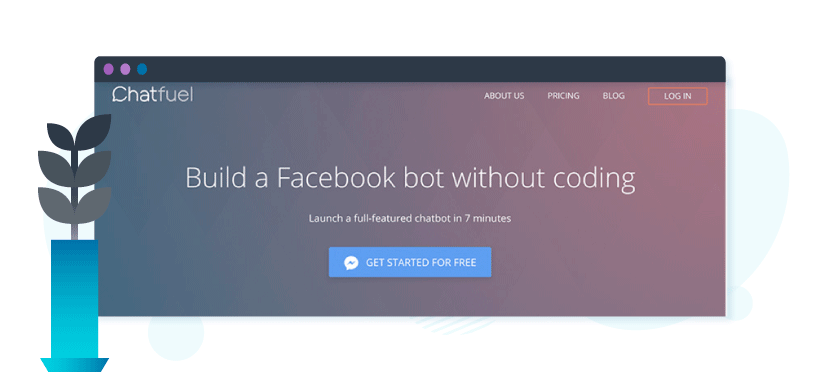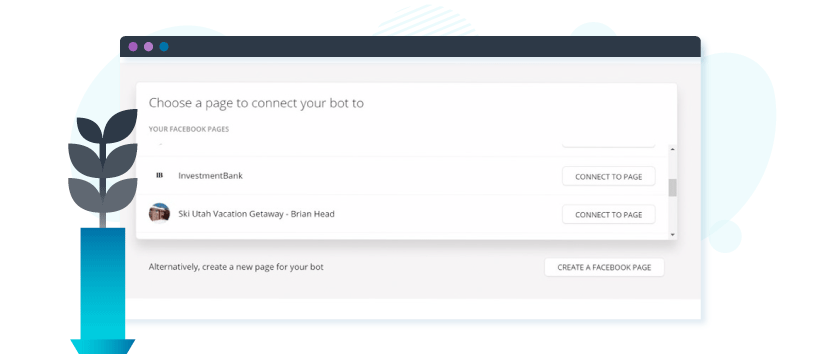This article was originally published in March 2017. It has been updated to reflect new information and application features available related to chatbots.
What if you had a medical problem and need to talk to a doctor in minutes instead of hours.
With chatbots, you can.
A number of medical chatbot applications are available — you install one on your phone, and you can get self-help diagnostic information for your ailments. Powered by artificial intelligence, you can have a conversation with a chatbot and get answers to your medical questions. It can even connect you with healthcare providers in real-time.
This article will break down how companies are applying the power of chatbots to marketing. We’ll cover how companies are using them, the best chatbots for lead generation, and how to start building one.
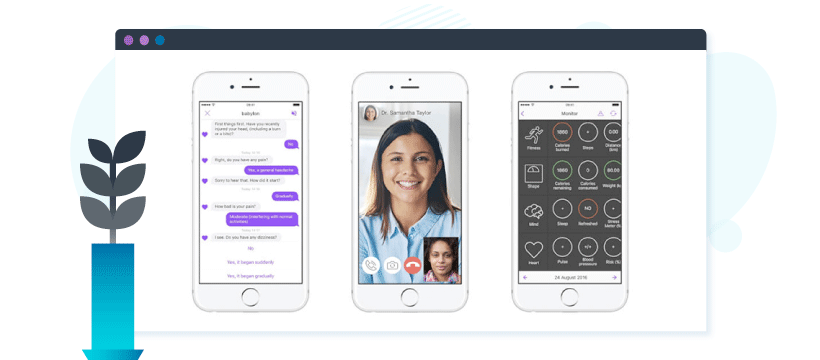
How are companies using chatbots in marketing?
Dozens of brands with large marketing budgets and initiatives, such as Disney, Uber, and Kayak, are using chatbots to connect with their customers and sell more products and services.
Disney, the enormous media and entertainment conglomerate, helped promote their ‘Zootopia’ movie with a Facebook Messenger chatbot that interacted with children. The chatbot led the child through a conversation with the movie’s main character, Officer Judy Hopps, as they worked together to catch bad guys.
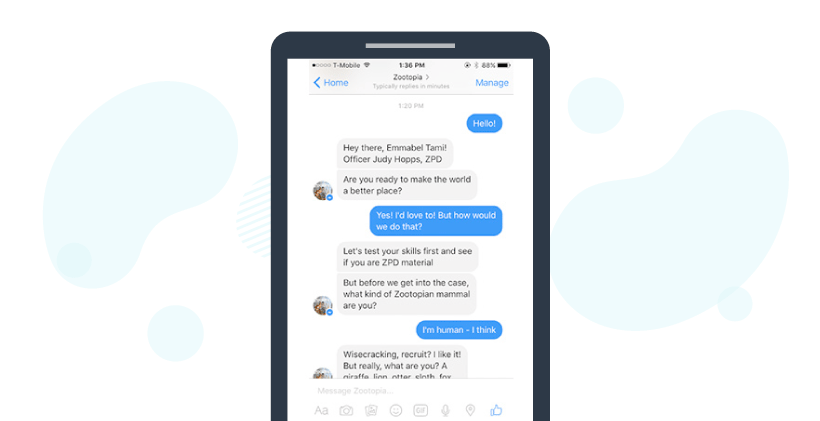
Kayak, one of the most popular air and hotel booking platforms, allows you to interact with its chatbots via Facebook Messenger, Slack or Amazon Alexa. Kayak’s main website provides tools for searching airlines and hotels and then booking them directly. With their chatbots, they are taking their service even further: You can receive budget-driven recommendations, get updates on your already-planned trips, or evaluate the best time to travel to certain hotspots.
Chatbots are meant to be more interactive ways to communicate with potential customers, not merely a way to help close a sale. As such, Kayak has introduced more conversational functionality beyond simply booking travel.
Likewise, chatbots can be leveraged in more creative fashions to generate leads.
Using chatbots to generate leads:
Traditional lead generation for both B2C and B2B marketing involves a lot of advertising and calls-to-action, such as “download this ebook,” to capture the lead for a sales follow-up.
Enter chatbots.
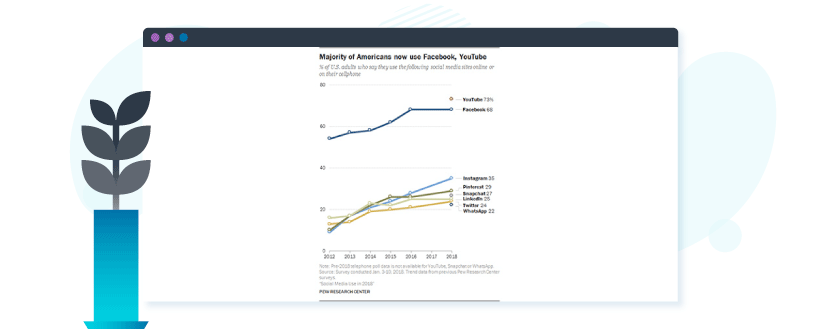
With 68 percent of online adults in the United States on Facebook, according to Pew Research, you can likely get your chatbot in front of your target demographic if you create a chatbot for Facebook. While Facebook Messenger is the leading platform for chatbots, there are also a number of other platforms available today. You can build chatbots using HubSpot, Slack, Skype, PureChat, Drift, and many others.
Any product or service that has a high level of pre-purchase decision-making, such as auto sales, real estate or enterprise software, can gain immense value from a chatbot. Because your prospective customer is likely doing a fair amount of online research into which product to buy, it makes sense to build a chatbot that helps answer questions for them, in a smart and conversational way.
Somewhere in the conversation your chatbot can offer a downloadable guide — all the prospective customer needs to do is provide some contact information, and the guide will be sent to them. Assuming your chatbot provides value to the consumer when your salesperson reaches out to discuss the sale, they will have already had a favorable interaction with your brand.
7 examples of chatbots for lead generation:
Despite chatbots having been around for some time now, lead generation via chatbots is still a very new technique. Not many people are leveraging them, and so there is still very much an early adopter advantage that you can get from launching a chatbot for lead generation.
To help you get a better idea of how you can leverage chatbots for this purpose, we’ve made a list of chatbots we’ve either built for clients or dreamed up and intended to build.
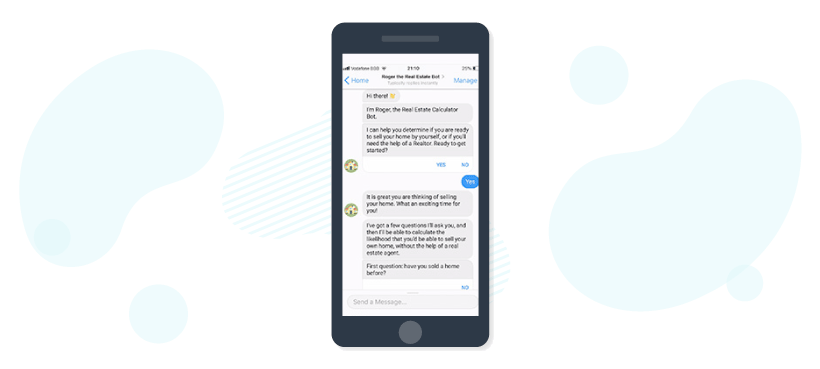
1. Real estate agent bots
Real estate agents rank among some of the most lead-hungry professionals out there. It is amazing what real estate agents will pay for a strong lead.
We’ve done several bot-building training sessions with this real estate agent bot example. If you’re interested in seeing more on this, be sure to read through to the end of this article, where we share an actual template you can copy and use for your own clients.
2. Loan calculator bots
Financial institutions that provide consumers or businesses with loans are always looking for ways to get more applications. Why not offer a loan calculator? After running the calculation in the chatbot, open up a dialog and offer a piece of free content, such as a guide on the “Ten things to ask a lender,” in exchange for a contact’s email address.
3. Life coach bots
A chatbot can be used to provide or offer free advice in the areas of coaching, psychology, or other forms of personal development and mental health.
4. Politician bots
What about politicians that need to reach thousands of constituents in their district, some that they can’t reach? In steps a bot that updates their voters in real-time via Facebook Messenger. And the great thing about Facebook is that it allows you to draw tight geographic fences around areas you want to advertise in. A politician can set targets around her district, buy ads, get people into her chatbot, and can take a more proactive approach and voice with her constituents, all of which can increase her chances of getting re-elected.
5. Investment advice bots
The financial planning industry is very competitive for new business. Advertise a guide on Facebook that is sure to whet the whistle for potential investors. Then, when they click your ad, it will take them into a chatbot. From there, capture their email addresses, and you’re gold!
6. Home services bots
Regardless of the type of home service you offer (or that your client offers), you can help automate quotes and lead generation for potential new customers. You can also provide home improvement advice through a chatbot to help you increase the number of new leads.
7. Appointment-setting bots
If you are involved in an appointment-heavy industry (hair salons, medical or dental offices, law firms, and so on), then you can leverage a chatbot as a method for current customers to book spots on your calendar. Simply opening up a dialog with your customers via Facebook Messenger will allow you to proactively reach out to them to follow up, solicit reviews and feedback, and to run “refer a friend” promotions.
How to start building a chatbot:
Years ago, chatbot-building was quite the task. It used to require coding knowledge, which often involved working with a skilled developer. By using Facebook Messenger, for example, you used to have to work directly with Facebook’s developer console to build a chatbot. However, over the years as chatbot functionality has become more widely used and available, building them has become significantly easier.
There are dozens of chatbot-building solutions out there, with three of the most popular for Facebook Messenger chatbots being Chatfuel, ManyChat, and Dialogflow (formerly called API.ai). Each of these solutions provides point-and-click, no-coding-necessary options for creating an interactive chatbot on the Facebook Messenger platform.
The big difference between ManyChat, Chatfuel, and Dialogflow:
- Chatfuel is super easy to get rolling with and does have a fairly robust feature set. We recommend it for beginners and small businesses who need an MVP (minimum viable product) they can try out quickly. For the DIY guide below, we will be using Chatfuel.
- ManyChat is also easy to use, and has come a long way in terms of robust features, usability, and integrations. After reviewing a number of customer testimonials, and experiencing ManyChat first hand, ManyChat and Facebook work closely together to ensure that product features, functionalities, and improvements are made regularly to provide users with the best possible experience.
- Dialogflow has also come a long way in terms of robust features and usability. Dialogflow used to come with a bit of a learning curve, however, today it is simple, easy to use, and doesn’t require coding. Dialogflow also offers a friendly user interface and supportive supplemental documentation to help beginner users learn and be successful with the platform. We recommend it for organizations that have more resources and are looking for a more powerful chatbot that can interface with their e-commerce solution or other enterprise-level tools.
How much do these tools cost? All three tools are available for free, up to a certain limit. For example, Chatfuel claims, that if you expect to see at least 500 users or more, then the paid Pro plan is recommended. Although ManyChat also offers a free version, it is somewhat limited. ManyChat’s free version is recommended for businesses or marketers that are new to building and using chatbots. Dialogflow offers a “Standard Edition” for free. Similar to Chatfuel, their paid plans are determined based on the number of requests. For example, pricing ranges between $0.002 and $0.004 per request for text.
All in all, depending on your business’ needs, you may be able to get pretty far with a free plan. However, even the paid plans with these of these applications are reasonably priced.
How to build a Facebook chatbot:
Now that you have a good understanding of what a chatbot is, how it can be used in lead generation, and the two leading platforms for building code-free chatbots, let’s jump into actually building one.
Creating a chatbot is such a simple process that it can be done by anyone with at least some technical prowess and about 10 minutes to spare.
Note: The “build it in about 10 minutes” claim is not promising a chatbot that will wow your potential customers. But, it will be enough time to build and launch a very basic chatbot. To build a feature-full chatbot with some immersive artificial intelligence that can carry on strong conversations, that will require some considerable time and effort on your part. This time isn’t spent actually building the tool, but you will be spending considerable time writing content, forecasting what the most frequently asked questions are going to be, etc.
Step 1: Connect your Facebook account to the Chatfuel chatbot builder.
This step is super easy. Make sure you’re logged into Facebook on the browser you’re going to connect to Chatfuel in. Then simply click the “get started for free” button on the Chatfuel homepage. It will bring up a Facebook connection page that allows you to give permissions to Chatfuel to see your Facebook information.
You need to authorize it, and you’ll then be taken back into the Chatfuel chatbot builder, where you’ll select which Facebook page you want to connect to.
Step 2: Connect to your Facebook business page.
Because chatbots are tied to organizations and not to individuals, you need to have an organization Facebook page that you use to tie your Chatbot to. If you don’t already have a Facebook page for the business you’re going to do marketing for, you should create one. Here’s a quick guide from Hootsuite to help you get started building a Facebook business page.
Alternatively, you can also click the “Create a Facebook page” button in the Chatfuel interface to set up your page at this step. However, setting up a Facebook page is very important, and you need to make sure you do it the right way, so we recommend going into Facebook to do it and using the above-linked guide. Then come back to Chatfuel.
Once you have a Facebook page, simply select it and you’re on your way.
Step 3: Walk through the in-app tutorial.
Now that you’ve connected your page, you’ll be taken into the actual chatbot builder. Chatfuel has a fairly detailed tutorial you can follow, though it’s not as good as this guide.
It does give you a good overview of the chatbot components and how to get started with their user interface. We do recommend you taking two or three minutes to click through their tutorial, as the background knowledge will help you on your way.
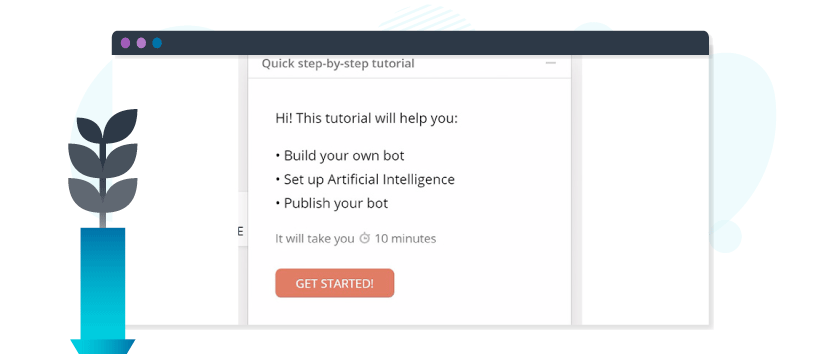
Step 4: Create your welcome message and default answer.
After the brief tutorial, the next step is to create your welcome message. The first interaction your chatbot visitors will have is with this message, so make it good.
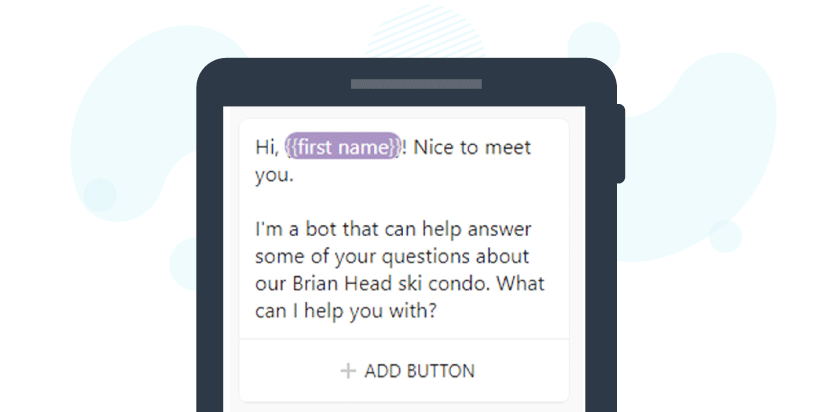
It should be a quick sentence that introduces the chatbot and then asks them, “How can I help?”
Make sure to also create a default message — something that’s shown in case the user types in a message which you don’t have AI detection set up for. It should say something along the lines of, “I’m not sure what you’re asking. Maybe some of the options below can help you.” Be sure to link your default message to your navigation items (discussed in the next step).
From this point, you have two options:
- You can have a navigation-type driven conversation (like a phone menu system)
- You can have artificial intelligence set up to guide the conversation
The latter is entirely possible with Chatfuel but requires considerable content development on your part. We’ll show you how you can set up AI conversations, but in the DIY guide we provide here, we will focus on getting an MVP version of a chatbot launched using navigation buttons and prompts.
Be honest with your audience.
We’ve always been a proponent, in bot building, of having your bot admit upfront that it actually is a bot. Most chatbot builders have followed the same guideline. Up until recently, the reason for having your bot admit that it was a bot was because our consumers expect (and should be given) transparent interactions with our companies. It just seemed like the right thing to do.
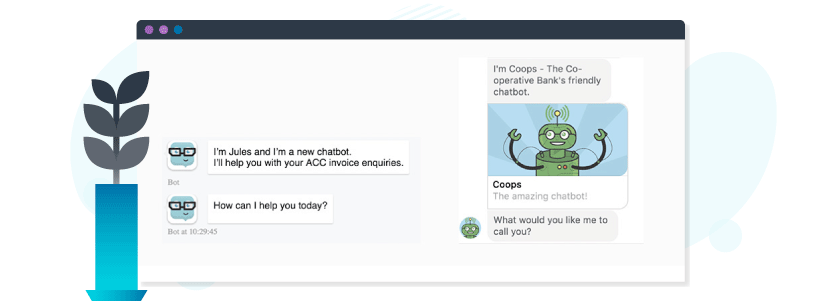
Recently though, it has become a law in California that your bot admits its true identity upfront… and assuming you’re not going to somehow block your bot from working in California, you’ll need to comply.
Step 5: Set up your conversation navigation.
In this step, you will build your conversation navigation, i.e., the means for an individual to work with your chatbot. In the example chatbot we’re building, we are trying to help our audience find answers to questions they might have about booking a Brian Head, Utah, ski condo.
There are dozens of questions a chatbot user might ask, but for the sake of launching this chatbot in 10 minutes, here are just a few questions we’ll program the chatbot to answer:
- Where is the ski condo?
- Do I have to drive from the condo to the resort?
- What are check-in and check-out hours?
- How many people does the condo sleep
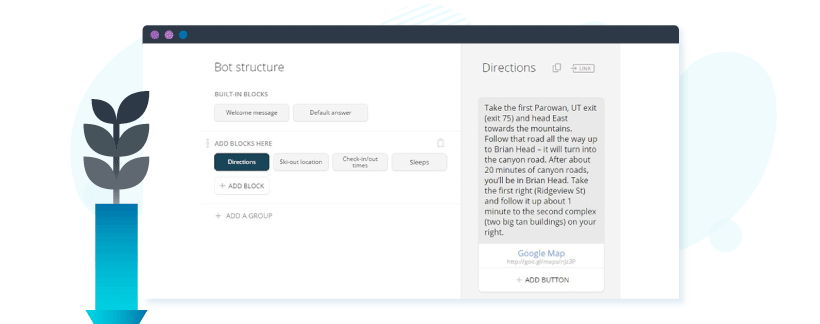
To set up the actual navigation, you should build a new “block” for each of these questions. It’s really easy; just click “add block,” and then type in a title for the block. Don’t worry about putting content in yet. Just create the blocks and title them.
Step 6: Link the blocks to the main navigation.
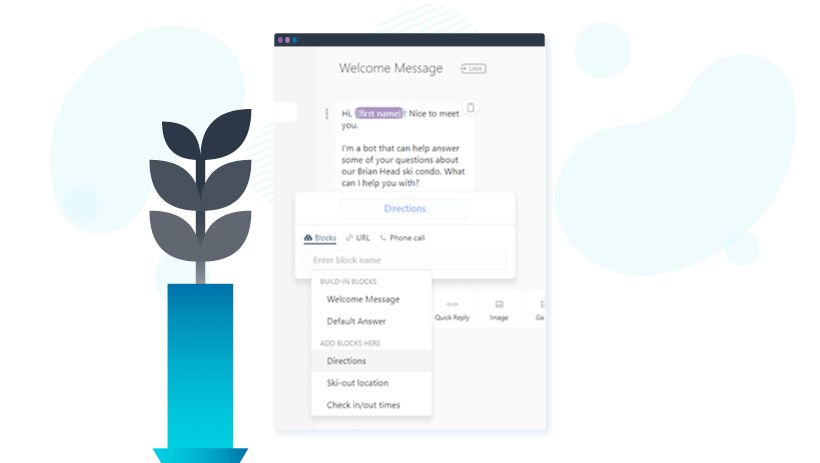
Go back to your main welcome message, and click the “add button” option on the message block. Type in the button name — what you want the user to see — in the first field. Then, in the next section, select “block,” and then you can select the block you’d like it to take the user to.
There are two other options you can link to:
- URL. Put in any URL you would like, and it will take the chatbot user outside of Facebook Messenger to that page. This can be good if you have an external booking or reservation system you would like to direct the visitor to when they ask a question about how to make a reservation.
- Phone call. Enter a phone number, and the user clicking that button will launch the phone’s dialer and pre-populate a phone number.
For this example, we’ll simply select block, and link to one of the blocks we’ve already set up.
Note: A chatbot works best when it’s conversational. So don’t have your chatbot present users with a long list of options. You want to have just a few top questions, and then have the rest of the logic built into the AI. Chatfuel forces this best practice by only allowing you to have three “buttons” on any given block. ManyChat and most other bot builders follow this same limitation — giving you only three buttons per block. For this example, we’re putting in just the top three most frequently asked questions, and then will build in the AI for other questions.
Step 7: Put in your chatbot dialog.

Now you can create the content that’s displayed when someone asks a specific question. Click on the block on the left, and it will bring up the empty block. Here, select a block type from the following options:
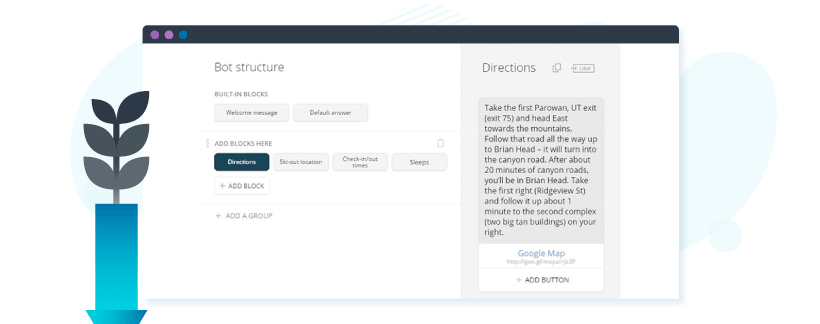
- Text card. This is Chatfuel’s most simple block type. You simply put text into this block. For simple answers, this is a great option.
- Typing. This simulates an actual human typing in the response. If you’ve used Facebook Messenger to chat with another human you’ve likely seen the little three dots at the bottom left of the window as someone is composing a message to you. You can recreate this effect in your bot, with this “typing” option. Even though it is important to disclose to your users that your bot is indeed a bot, you may still want to use this typing delay to make the conversation seem more realistic.
- Quick reply. If you build this option into a block, instead of taking them to a new card for an answer, it simply shows a reply. In this way, it behaves more like a chat thread you would be having with a real person.
- Image. This is another simple block type. With the image block, you upload an image and when triggered in conversation, it simply shows that image.
- Gallery. This is your best bet if you want to add a few pictures to an answer. In this example, if someone asks, “Can I see some pictures?” we’re assuming they want to see pictures of the ski condo. We would use this gallery and put in a few pictures, a heading that describes what the picture is, and then a subtitle or description. You can also add a URL for each image. You can get really creative with these and use them similar to Facebook’s Carousel Format ads.
- Go to Block. Selecting this option allows you to send your chatbot user on to another specific block, or small component of a conversational dialog.
- To Sequence. Similar to the “go to block” functionality, this allows you to redirect a user to a completely new conversational sequence. A sequence usually contains many blocks.
- +. This “+” sign takes you to a menu of numerous plugins that enable you to integrate your chatbot with other third-party apps or leverage more powerful options inside of Chatfuel. This is one area where Dialogflow is more powerful; Dialogflow has a lot more integration options than with Chatfuel. That said, Chatfuel does have some excellent integrations and will fulfill most chatbot builders’ needs. For example, in the case of a ski condo, you could integrate your chatbot with IFTTT so that when someone asks, “How much snow is there at Brian Head?” the chatbot will talk to IFTTT, which will, in turn, contact your Instagram feed and pull in the latest image you have tagged with #brianheadsnowconditions and the chatbot will then display that image. Sweet, huh!?
Go ahead and use a simple text card to create an answer for each question/answer segment you want the chatbot to support.
Step 8: Create your artificial intelligence.
After you’ve built out all your content blocks, go ahead and click on the “Set up AI” link in the left-side navigation. Here you get to brainstorm all the questions that might be asked of your chatbot and set up answers. The answers can either be new text you enter in this stage, or you can direct them to one of the blocks of content you’ve previously set up.
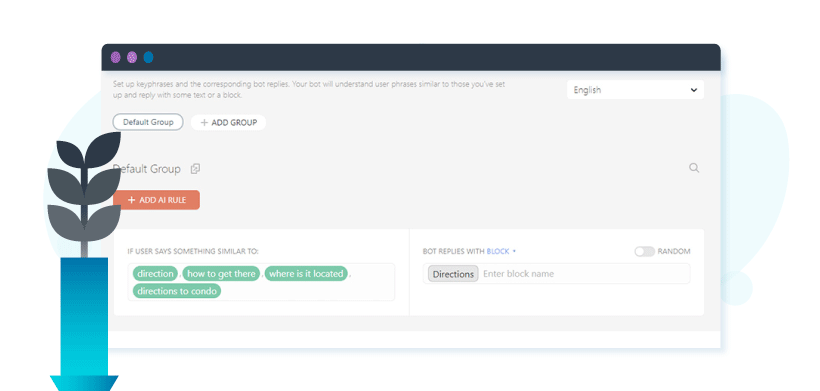
There are two components to this step:
- Phrases to watch for. This is where you put in the different words or phrases you want the chatbot to watch for. For example, in the above example, if a user types in a question or phrase with “directions” in it, the chatbot can return actual directions.
- Content to display. After the chatbot detects a word or phrase in the conversation, it will return the content you’ve specified. There is a little drop-down where you can select “text” or “block.” If you select text, it will allow you to enter a new text response. If you select block, you can choose the block you want to display and the chatbot will show that content instead.
Step 9: Launch the chatbot
Chatfuel excels at launching your chatbot. In fact, it is already ready to go — as you build your chatbot, Chatfuel is saving and making all your changes live, immediately.
This’s nice because there’s nothing you need to do to launch your chatbot, other than getting the link and putting it on your website, Facebook page, or in your online ads.
All you have to do is click on the “Promote” page in the left-hand navigation menu, and then copy the URL at the top of the page.
Share that URL liberally!
What other bot-building tools are there?
Just a year ago, we could count the bot-building tools on two hands and two feet. As the marketing potential for bots has proliferated, so too has the number of bot-building tools.
Below are a few bot-builders we consider to be the leaders in the space, listed in order from easiest to most complex:
- Chatfuel
This bot-builder, as we’ve outlined in the rest of this article, is what we consider to be one of the easiest bot-builders around. That said, Chatfuel still has some robust functionality and would be a good fit for most use cases. It even has a built-in native payment processing feature. This allows users to make purchases directly from your bot. - ManyChat
This is another of our favorite chatbot builders. As we indicated in the section above about lead generation examples, the real estate chatbot that we’ve built was on the ManyChat platform, and was a beauty to build. ManyChat has a very visual builder, called a workflow builder, that makes creating chatbots a breeze. Here is an example of ManyChat’s workflow builder, being used for post-Shopify order communication:
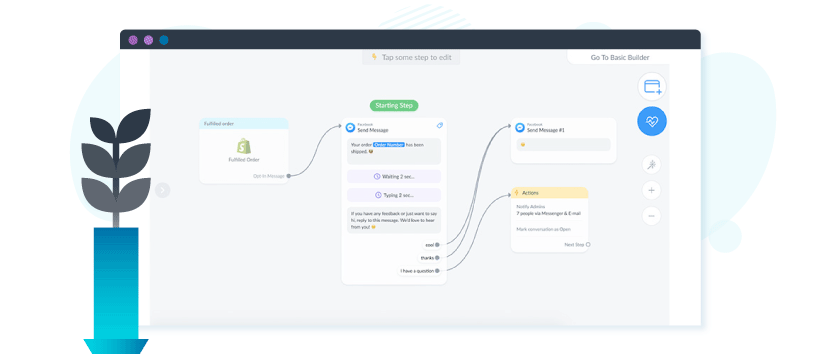 Source: ManyChat
Source: ManyChat
- Flow XO
Flow XO began life as an integration platform between chatbots and other tools. It was like the Zapier of chatbots. However, they quickly realized that if they built a chatbot building platform they could gather even greater market share, and so they did. If you need heavy integrations with other third-party tools (Salesforce, Marketo, Google Sheets… practically anything) then we recommend Flow XO. It isn’t nearly as graceful to use as ManyChat or Chatfuel, though. - Dialogflow
Originally called API.ai, Dialogflow is a powerful bot-builder maintained by Google. With Dialogflow you have the most functionality of any bot-builders out there, but leveraging the advanced functionality often requires the help of a developer. With Flow XO, ManyChat, and Chatfuel you can build your own bot with no programming expertise. - Bot Framework
Microsoft has some of the most powerful natural language processing available and allows chatbot builders to leverage their system through the Bot Framework. So, if you’re looking to have a human-sounding bot, this chatbot-builder platform may be right for you. Something to keep in mind, though: You’ll need a true developer (or a dozen) to build a bot on the Bot Framework.

Bonus chatbot niches
We’ve started to see new chatbot builders enter the industry that have niche offerings. Instead of being able to build full-feature bots, they are providing a platform to do a smaller niche process, and do it exceptionally well.
MobileMonkey
MobileMonkey specifically fills a niche need of getting live-chat experiences on to websites, which remember previous conversations to build upon those for future interactions. MobileMonkey makes on-site conversations possible for those building Facebook Messenger bots. They also boast the ability to remember conversations, between conversations, in order to improve the continuity of user experience. They also boast the ability to remember conversations, between conversations, in order to improve the continuity of user experience.
Pypestream
Pypestream is a conversational AI chatbot designed to scale. It is designed in such a way to help customer-centric businesses and enterprises move into the digital age easily as well as provide ongoing stellar customer experiences. One of the primary reasons why we added Pypestream to this article is it is designed to handle any user volume without any embarrassing chatbots mistakes or inefficiencies, or poor customer satisfaction scores. Pypestream is an interesting newcomer that has already won some big clients like Chase, Sling TV, and Royal Caribbean.
Build a chatbot to build your business
In summary, building a chatbot isn’t as complex as it might seem. By leveraging the right chatbot tools, you can not only streamline your customer service and support operations, but you can also provide your customers with a fast, efficient, and valuable experience.
Chatbots are here to stay, so start building yours today. And if you’d rather have some help, talk to one of our strategists today to partner with us and skyrocket your lead generation.
